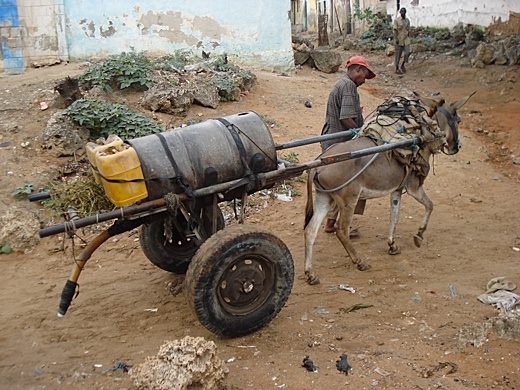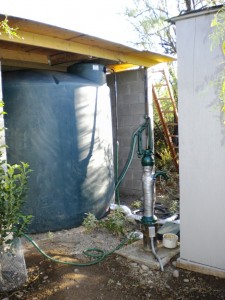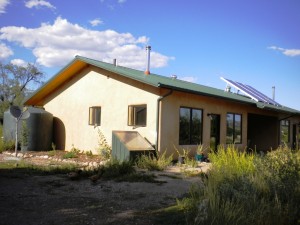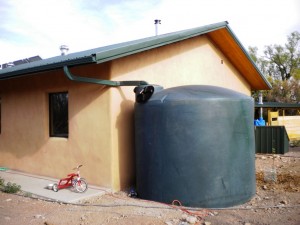SUBHEAD: Securing a potable supply of water is fundamental to life.
By Guy McPherson on 24 March 2010 in Nature Bats Last -
(http://guymcpherson.com/2010/03/what-works-water)

Image above: Water is hauled by a network of donkey cart in Mogadishu. From (http://ipsnews.net/africa/nota.asp?idnews=43548)
Securing a potable supply of water is fundamental to life, including human life. Human members of industrialized societies have grown accustomed to water delivery in every home. Contrary to a vast majority of the human experience, we simply take for granted water coming out every tap when we turn the handle.
Adding to the absurdity, I will continue making the same assumption for properly prepared properties. At the mud hut, we have designed and constructed a water extraction and delivery system to keep the water flowing well into the post-carbon era. Annual average precipitation on this particular site is about 35 cm (14 inches), so gardening is aided by supplemental water.
We have two wells on the property. The first has been here for years, and is tied to the grid in conventional fashion.
The local well inspector found this well clogged with roots or other undetermined nasties, and the cost of rectifying the situation would have approached the cost of a new well. We continue to use the old grid-tied well, but only periodically, while we transition to a recently drilled, solar-powered well.
The new well is drilled to a depth of 31 m (102 ft). The water table is at 6 m (20 ft), and lenses of sandy soil provide abundant water down to 20 m (65 ft) or so, at which point a conglomerate layer dominates.
This layer is characterized by very sweet, high-quality water tucked into the cracks of the conglomerate. The solar pump sits at 27 m (90 ft), and we have a hand pump at 14 m (45 ft) down the same well pipe. We use the hand pump quite frequently because it is conveniently located near the goat shed.

The solar pump feeds water into a 3,000-gallon cistern (behind the hand pump, and protected by a block wall on three sides). We simply turn a mechanical switch to the “on” position every week or so to fill the cistern. From the cistern, gravity feeds the water into a pressure pump, which supplies a pressure tank, which pressurizes the water lines throughout the property.
We installed several hundred feet of 3/4” water lines. These lead to both houses (the old mobile home and the new straw-bale house, and from the latter to the outdoor kitchen), as well as to eight frost-free hydrants strategically located near garden beds, greenhouses, cold frames, the orchard, and animal pens.
We made a minor error when we ran a 1/2” water line off the 3/4″ line for a short run to one of the frost-free hydrants. The combination of narrower pipe buried only 18 inches deep and located on the north side of the straw-bale house where the sun fails to hit the ground all winter led to a burst water line where the 1/2″ line tees off the 3/4″ line. We fixed the line with new pipe and buried it deeper.
Had we not been able to buy an inexpensive piece of PVC at the hardware store, we’d have had no water throughout the property from that day forward. I’ve stocked up on those inexpensive pieces of PVC — tees, ball valves, plugs, and so on — and this spring, after the ground thaws, I’ll move the line over a few meters so it will receive morning sun.
Domestic water is pre-heated by passive solar water heaters adjacent to the east and west sides of the straw-bale house. Each water heater contains a 42-gallon tank painted black within an insulated box.
The pre-heated water from each tank goes directly into a six-gallon electric water heater within the house. We considered on-demand electric water heaters, but the pulse of electricity would have required a PV solar system about three times the size of the too-expensive one we installed, so the passive solar pre-heaters and small electric water heaters represent a relatively durable, low-cost compromise. And we’ll have hot showers long after the industrial age ends.

All the fixtures in the straw-bale house were selected with durability in mind. I’ll not provide free advertising by revealing the brand online, but let me know via email if you’d like to learn the “best” brand (according to the contractors with whom we corresponded). Here’s a hint: It’s not American Standard.
Although the mobile home has a septic system (a remnant from earlier years), trees are watered by all water leaving the straw-bale house (from two kitchen sinks, two bathroom showers, and sinks in the kitchens and bathrooms). No “blackwater” leaves the house because we use composting toilets. Water departing the straw-bale house spills into French drains adjacent to trees.
Another minor error warrants description: The initial French drains were too shallow, so they were hand-dug twice.
The second version filled in with sediment, and one line was clogged with a pack rat, so I dug it again.
This time, I dug a gihugic hole and filled the hole with large used tires; then I ran the drainpipe into the top of a large hole within the stacked tires, and covered the entire contraption with roofing tin before covering it with soil.
I think this arrangement will deter all but the wiliest rats, and sediment should not fill the French drain for a couple decades. I’ll be long dead by then, indifferent to wily rats and sediment.
A 3,000-gallon cistern is filled by runoff from each of the two houses. We use this water for plants, although it would be potable with minimal treatment. The water is sieved before entering the cisterns. At some point, we probably will use this rainwater for making soap because rainwater’s inherent softness is perfect for handmade soap.

We also harvest rainwater from surface runoff. The property slopes at about 5% from north to south, and the richest soils are located on the south side of the property, so we “steer” the south-bound runoff with berms that direct the overland flow into large gardens.
Finally, the nearby river serves as a final source of water, if needed. Near our property, the river is perennial during most years, which explains the shallow groundwater on the property we occupy. If the other sources of water fail to keep us satiated in the years ahead, we’ll carry water from the river just as people did during the previous Stone Age.
.
By Guy McPherson on 24 March 2010 in Nature Bats Last -
(http://guymcpherson.com/2010/03/what-works-water)

Image above: Water is hauled by a network of donkey cart in Mogadishu. From (http://ipsnews.net/africa/nota.asp?idnews=43548)
Securing a potable supply of water is fundamental to life, including human life. Human members of industrialized societies have grown accustomed to water delivery in every home. Contrary to a vast majority of the human experience, we simply take for granted water coming out every tap when we turn the handle.
Adding to the absurdity, I will continue making the same assumption for properly prepared properties. At the mud hut, we have designed and constructed a water extraction and delivery system to keep the water flowing well into the post-carbon era. Annual average precipitation on this particular site is about 35 cm (14 inches), so gardening is aided by supplemental water.
We have two wells on the property. The first has been here for years, and is tied to the grid in conventional fashion.
The local well inspector found this well clogged with roots or other undetermined nasties, and the cost of rectifying the situation would have approached the cost of a new well. We continue to use the old grid-tied well, but only periodically, while we transition to a recently drilled, solar-powered well.
The new well is drilled to a depth of 31 m (102 ft). The water table is at 6 m (20 ft), and lenses of sandy soil provide abundant water down to 20 m (65 ft) or so, at which point a conglomerate layer dominates.
This layer is characterized by very sweet, high-quality water tucked into the cracks of the conglomerate. The solar pump sits at 27 m (90 ft), and we have a hand pump at 14 m (45 ft) down the same well pipe. We use the hand pump quite frequently because it is conveniently located near the goat shed.

The solar pump feeds water into a 3,000-gallon cistern (behind the hand pump, and protected by a block wall on three sides). We simply turn a mechanical switch to the “on” position every week or so to fill the cistern. From the cistern, gravity feeds the water into a pressure pump, which supplies a pressure tank, which pressurizes the water lines throughout the property.
We installed several hundred feet of 3/4” water lines. These lead to both houses (the old mobile home and the new straw-bale house, and from the latter to the outdoor kitchen), as well as to eight frost-free hydrants strategically located near garden beds, greenhouses, cold frames, the orchard, and animal pens.
We made a minor error when we ran a 1/2” water line off the 3/4″ line for a short run to one of the frost-free hydrants. The combination of narrower pipe buried only 18 inches deep and located on the north side of the straw-bale house where the sun fails to hit the ground all winter led to a burst water line where the 1/2″ line tees off the 3/4″ line. We fixed the line with new pipe and buried it deeper.
Had we not been able to buy an inexpensive piece of PVC at the hardware store, we’d have had no water throughout the property from that day forward. I’ve stocked up on those inexpensive pieces of PVC — tees, ball valves, plugs, and so on — and this spring, after the ground thaws, I’ll move the line over a few meters so it will receive morning sun.
Domestic water is pre-heated by passive solar water heaters adjacent to the east and west sides of the straw-bale house. Each water heater contains a 42-gallon tank painted black within an insulated box.
The pre-heated water from each tank goes directly into a six-gallon electric water heater within the house. We considered on-demand electric water heaters, but the pulse of electricity would have required a PV solar system about three times the size of the too-expensive one we installed, so the passive solar pre-heaters and small electric water heaters represent a relatively durable, low-cost compromise. And we’ll have hot showers long after the industrial age ends.

All the fixtures in the straw-bale house were selected with durability in mind. I’ll not provide free advertising by revealing the brand online, but let me know via email if you’d like to learn the “best” brand (according to the contractors with whom we corresponded). Here’s a hint: It’s not American Standard.
Although the mobile home has a septic system (a remnant from earlier years), trees are watered by all water leaving the straw-bale house (from two kitchen sinks, two bathroom showers, and sinks in the kitchens and bathrooms). No “blackwater” leaves the house because we use composting toilets. Water departing the straw-bale house spills into French drains adjacent to trees.
Another minor error warrants description: The initial French drains were too shallow, so they were hand-dug twice.
The second version filled in with sediment, and one line was clogged with a pack rat, so I dug it again.
This time, I dug a gihugic hole and filled the hole with large used tires; then I ran the drainpipe into the top of a large hole within the stacked tires, and covered the entire contraption with roofing tin before covering it with soil.
I think this arrangement will deter all but the wiliest rats, and sediment should not fill the French drain for a couple decades. I’ll be long dead by then, indifferent to wily rats and sediment.
A 3,000-gallon cistern is filled by runoff from each of the two houses. We use this water for plants, although it would be potable with minimal treatment. The water is sieved before entering the cisterns. At some point, we probably will use this rainwater for making soap because rainwater’s inherent softness is perfect for handmade soap.

We also harvest rainwater from surface runoff. The property slopes at about 5% from north to south, and the richest soils are located on the south side of the property, so we “steer” the south-bound runoff with berms that direct the overland flow into large gardens.
Finally, the nearby river serves as a final source of water, if needed. Near our property, the river is perennial during most years, which explains the shallow groundwater on the property we occupy. If the other sources of water fail to keep us satiated in the years ahead, we’ll carry water from the river just as people did during the previous Stone Age.
.
No comments :
Post a Comment